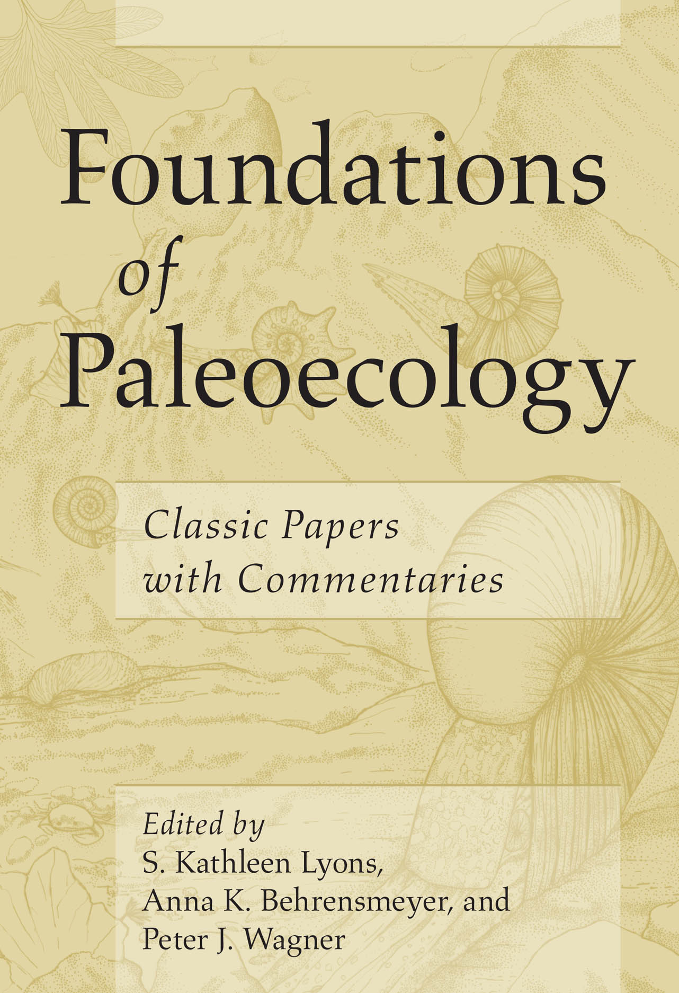Reviewed by Richard Lis (California Department of Fish and Wildlife, CA)

Lyons, S.K., A.K. Behrensmeyer, and P.J. Wagner, eds. 2019. Foundations of Paleoecology: Classic Papers with Commentaries. University of Chicago Press, Chicago & London, UK. 800 pp. ($96.60 cloth, $38.40 paper, $38.39 e-book with 40% PS discount.)
The collections of papers that have been assembled into this book provides a remarkable coverage of the field of paleoecology that will be of interest to all paleontologists and any paleobiologists interested in paleoecology. The papers are broken into six parts. Part One (Community and Ecosystem Dynamics) is composed of eight papers; Part Two (Community Reconstruction) contains six papers; Part Three (Diversity Dynamics) contains eight papers; Part Four (Paleoenvironmental Reconstruction) is comprised of six papers; Part Five (Species Interactions) has seven papers; and Part Six (Taphonomy) contains eight papers. Each of the six parts has an introduction to conceptualize and summarize the part, then each paper has its own commentary that explains it significance to paleoecology and why it has special significance. I found the introductions to each major part quite interesting as a brief history of the development of that area of study and the commentaries to each paper provided extended context to my reading and understanding of the significance of each paper. The editors focused on papers from the twentieth century and they range in date from 1924 to 1999.
I was pleasantly surprised by the diversity of papers across these various parts of the text and examined the papers for four types of organismal focus: invertebrates, vertebrates, plants, or no specific organismal emphasis. Of the 44 total papers, 19 had an invertebrate emphasis, 8 focused on vertebrates, 11 were paleobotanical, and 5 had no specific organismal focus. I found this to be a well-balanced treatment of paleoecology covering the three primary divisions of paleontology. My primary field of research is paleobotany and I found a number of invertebrate and vertebrate papers in this volume to contain interesting insights and methodologies that would be applicable to my research that I would not have found otherwise. There were a number of papers I was familiar with and had read multiple times, but reading the introductory commentaries gave me new understandings of their place and importance in the field of paleoecology, and inspired me to re-read the papers.
I also found the diversity of papers interesting in the various graphics and diagrams that authors of these papers produced. I found myself drawn to read various papers to understand the diagram or chart in more detail because it appeared to be one that I may be able to use to illustrate work I am preparing. This was an unexpected benefit of reading this book and having a single volume with such a diversity of papers.
Overall the book is printed very nicely and the papers were reprinted in their original form as they appeared when first published. In a few cases, certain tables or graphics are small, faint, or did not reproduce clearly, but they are readable. The only major error I found in my copy was in Part Two, in the paper by Leo J. Hickey and James A. Doyle (1977, Early Cretaceous Fossil Evidence for Angiosperm Evolution, The Botanical Review). Three sections of pages were missing from this paper, which I am referring to here in the page numbers of the original publication, pages 5–11, 19–72, and 82–93. Within the text of this book, the pages are sequentially numbered from 138 to 165, thus only 27 pages of the original 101 pages made it into the volume. Given that the pages are numbered sequentially in the book, it appears the omission of pages occurred prior to compilation and printing. This is a shame these pages are missing from this paper. This was the only paper in which I found missing pages. If this book is reprinted, adding all the pages to this paper is a needed correction to the book.
The editors and contributors to the volume produced an outstanding compendium of paleoecological papers and selected such an array of papers that paleontologists of all specialties will find it of great interest. The diversity of papers will certainly help readers look outside their field to find new ideas that may be applied within their area of study. I found the oldest papers and their commentaries particularly interesting to read because they broadened my understanding of the development of paleoecology. This book will also be useful to paleontologists and historians of science interested in the development of paleoecology from the 1920s to 2000. I highly recommend this book to anyone interested in paleoecology as it truly does provide an excellent foundation of papers for study and research.

